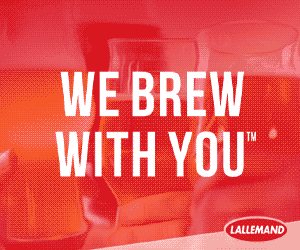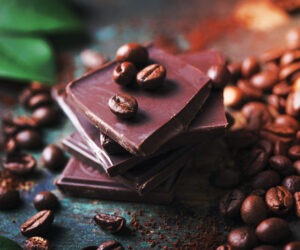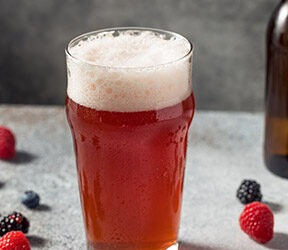Brewing with Honey
When people think about honey brewing, one word comes to mind: mead. The classic honey wine, drink of the druids and Vikings, mead is the heavy hitter of honey drinks. Along with variants like pyment (grape mead), cyser (apple mead) and metheglin (spiced mead), mead seems to corner the market on honey fermentation. But what else can you do with honey?
The answer is: plenty. Honey is a versatile, highly-fermentable substance that’s great in specialty and holiday beers, nut brown or pumpkin ales, and especially strong beers that you intend to age for a while. But just about any style can benefit from honey. Cream stouts, porters, light lagers, pale ales and witbiers, not to mention Belgian ales, are just a few of the possibilities.
Honey’s Contributions to Beer
Why add honey to beer? For the most part, the brewer adds honey for the same reasons that you would add any sugar: to raise the alcoholic content of beer while lightening the body. The goal may also be to add some sweetness. But honey ferments out so completely (95% of the carbohydrates) that very little honey character will be left in the beer — unless you take special precautions.
In fact, many honey beers have no residual sweetness. So the essential rule is, if you want a lot of honey character, add diluted, heat-treated honey to the primary fermenter (more on how to heat honey later). And if you want more alcohol, add honey to the boil.
The real strength of honey is that it adds potency and lightness to beer, as other sugars do, yet smoothes out the roughness that inevitably comes from adding sugar. We’ve found that honey also seems to knock the bitter edge off the hops while allowing some of the more subtle hop character to come through. Of course, if you want a strongly hoppy honey beer, you can always add more high-alpha-acid hops to the kettle. Honey also adds subtle floral notes and aroma to beer, thanks to the various pollens and nectars used by bees in its production.
Honey is an all-natural substance, and is best for brewing in its raw, unheated and unprocessed state. At this point all of its vitamins, antiseptic qualities and nutrients are intact. The crystal-clear honey you see in the supermarket has been heat-treated and filtered to stay that way. Not that your basic commercial honey won’t make good beer. If that’s what you can get, that’s what you should use. Another point in favor of honey beers is that they don’t take as long as most meads. We like mead and make it once in a while (we’re drinking a nice strawberry mead right now), but it’s hard to wait for the yeast to digest all of that fructose. Meads can take months to ferment out completely, and should be aged at least a year. Honey beers, on the other hand, take only a few weeks to ferment and age to perfection in a month or so.
Brewing with Honey
Honey is flower nectar that is gathered, condensed and stored by bees. It contains roughly 80 percent sugars, mostly glucose and fructose (with some other sugars and complex carbohydrates thrown in), 17.5 percent water, proteins and amino acids, trace amounts of vitamins and minerals, anti-oxidants and enzymes. Wild yeast may also be present.
Owing to its low water content, honey is very stable. Its microorganisms are dormant until they access an appropriate medium, such as your wort, where they have the potential to spoil your beer. Honey also contains various enyzmes that, if not denatured by heat, could go to work in your fermenting wort, resulting in a beer that’s drier than you might have intended.
There are two ways of dealing with wild yeast and enzymes. The method we use use is brute force. Adding honey to the beginning of a long, furious boil will kill the yeast, deactivate enzymes and remove any beeswax. The downside is that the delicate flavors and aromas of the honey may be lost, and no residual honey sweetness will remain in the finished beer. The other alternative involves “home pasteurizing” the honey and adding it to the fermenter.
If you are motivated to try the pasteurization method, here it is. Note that a beer produced this way will have to be mashed at a slightly higher temperature (155-162° F) to produce enough dextrins to compensate for adding the diluted honey. It will also be useful to brew a smaller batch to allow carboy space for the honey water. To prevent alcohol levels from becoming too high, start with low- to medium-gravity beers when using this method.
Preheat the oven to 176° F. Place the honey in a sanitized, oven-proof saucepan. Heat the honey on the stovetop to 176° F. The honey should be stirred occasionally to avoid burning it. When the honey reaches 176° F, cover the pan and place it in the oven. Use a thermometer, and hold the honey in the oven at 176° F for 2.5 hours. Then bring the honey to room temperature by placing it in an ice bath. (If you can’t hold the honey mixture at precisely 176° F, any temperature from 176–185° F will be fine.)
Now add the honey to sufficient boiled water to match the starting specific gravity of your beer. Honey varies tremendously in most of its characteristics, including specific gravity. As a rough guide, 1 pound of honey dissolved in 1 gallon of water should yield an SG of about 1.032 to 1.038.
Start by taking a gravity reading of your beer wort. Say you’re brewing a nut brown honey ale with a gravity of 1.040. You’ve brewed a three-gallon batch at high mashing temperatures, and you’d like to add some clover honey. Bring two gallons of water to a boil. Take a gravity reading of the water (it should be 1.000 at 70° F). Dissolve one pound of honey in the water and take another reading (it should be 1.017 to 1.019). Use this figure and some simple math to estimate the amount of honey needed. Continue adding honey and taking readings until a reading of 1.040 is reached. Depending on the gravity of the honey, it could take from 1.10 to 1.36 more pounds of honey to reach target gravity. When the wort is at high krausen (when the yeast activity is at its peak), add the honey.
The National Honey Board has done research into the effects of honey on beer. Their recommendations for amounts of honey added to a batch of beer (as a percent of total fermentables) are: 3 to 10 percent honey produces a subtle, floral flavor and delicate aroma; 11 to 30 percent produces a robust honey flavor that should be balanced by strong hop flavors, spices, or darker specialty malts; above 30 percent produces beer dominated by honey flavor, which verges on being what medieval brewers called “braggot.”
The sources of nectar used by bees influence both the color and flavor of honey. Matching types of honey to beer styles is an inexact science, but in general the stronger and darker the honey, the stronger and darker the beer. Clover and alfalfa honey are mild-flavored, light honeys suitable for most beers. Orange blossom, raspberry and sage honeys are paler and more delicate, suited to spiced ales, holiday beers and light lagers. Blueberry and wildflower honeys are darker, robust and fruity, matching well with pale ales, fruit beers, spiced beers and stouts. Buckwheat honey is the darkest and strongest of all, and should be reserved for stouts and porters. You might also try honey from the tupelo tree, which is highly prized and has a distinctive flavor.
Getting your hands on some honey
Our honey bill for brewing is close to twenty pounds annually. Buying that much at retail prices can get expensive. One path to good, cheap honey is the beekeepers at your farmers’ market. They are usually happy to strike a deal for bulk honey, and often have buckets that have slightly crystallized but which are fine for brewing. You can also check www.honeylocator.com. This National Honey Board site helps you find honey suppliers all across the country, and you can search by honey variety and location.
HONEY BEER RECIPES
Passagassawakeag Porter
(5 gallons, extract with grains)
OG: 1.085 FG: 1.020
SRM: 25 IBU: 25–30
Mighty malty with a nice hop nose, slight bitterness and a strong alcohol bite, this is a powerful sipping beer.
Ingredients
- 0.25 lb. roasted malt
- 1 lb. British crystal malt (80° L)
- 2 lbs. Munich malt
- 3 lbs. dark crystal dry malt extract
- 4 lbs. Edme IPA kit
- 1 qt. wildflower honey
- 6 AAU UK Progress hops
- (1 oz. of 6% alpha acid)(60 min.)
- 2.5 AAU East Kent Goldings hops
- (0.5 oz. of 5% alpha acid) (60 min.)
- 0.5 oz. East Kent Goldings hops (15 min.)
- 0.5 oz. UK WGV hops (15 min.)
- (Whitbread Goldings Variety)
- 0.5 oz. UK WGV hops (2 min. steep)
- Wyeast 1968 (Special London)
- 0.6 cup corn sugar for bottling
Step by Step
Heat 3 gallons cold water to 155° F. Mash-in grains and hold at 150° F for 1 hour. Sparge with 3 gallons of 170° F water and collect 5.5 gallons runoff. Add extracts and honey and stir to dissolve. Bring to a boil and follow hop schedule above. Cool wort to 75° F and rack to a carboy. Top up to 5 gallons (if necessary) and add yeast. Ferment at 65° F for 3 to 4 weeks. Bottle or keg when fermentation is complete. Age beer 6 weeks before tasting.
All-grain option: Replace the dark crystal malt extract and Edme ale kit with 1 more lb. of British crystal malt (60° L) and 9 lbs. English mild ale malt. Add another 0.5 oz. Progress bittering hops to replace hop extract in the kit.
Beer Cabinet Bee Brew
(5 gallons, extract with grains)
OG: 1.070 FG: 1.015
SRM: 2 IBU: 32
A good clean pilsner we brewed last winter from leftover ingredients.
Ingredients
- 0.25 lb. Vienna malt
- 0.5 lb. pale malt
- 2 oz. toasted malt
- 3.3 lbs. Muntons hopped light extract
- 2 lbs. hopped extra-light dry extract
- 1.25 lbs. light dry extract
- 2 lbs. clover honey
- 5.5 AAU Chinook hops
- (0.5 oz. of 11% alpha acid) (30 min.)
- 1.5 oz. Willamette hops (15 min.)
- 0.5 oz. Saaz hops (3 min. steep)
- Wyeast 2007 (Pilsen Lager) yeast or White Labs WLP800 (Pilsen Lager)
Step by step
Mash-in grains with 2.5 gallons of 160° F water. Hold at 160° F for 30 minutes, strain and sparge with 0.5 gallon boiling water. Add extracts and honey, bring to boil. Boil 10 minutes before adding hops. Boil, following hop schedule above. Cool wort to 75° F with a wort chiller. Strain into a carboy with 1.5 gallons chilled water. Top up to 5 gallons and add yeast. Ferment at 40 to 45° F for 1 to 2 weeks. Rack off to a secondary and lager for 6 weeks. Bottle or keg when lagering is complete. Age 6 weeks before tasting.
Honey Basil Ale
(5 gallons, all grain)
OG: 1.062 FG: 1.012
SRM: 10 IBU: 25
This beer uses the pasteurization method of adding honey, as well as fresh basil leaves for extra bitterness.
Ingredients
- 0.25 lb. toasted malt
- 0.3 lb. wheat malt
- 6.5 lbs. English mild ale malt
- 0.5 lb. unpasteurized raw honey
- 5.5 AAU Willamette hops
- (1 oz. of 5.5% alpha acid) (60 min.)
- 0.5 oz. fresh basil leaves
- 0.5 oz. Willamette hops
- Wyeast 1052 (American Ale) yeast
- 3 lbs. pasteurized alfalfa honey
- 0.6 cup priming sugar
Step by step
Raise 3 gallons water to 160° F. Add 0.5 lb. unpasteurized raw honey, stir to dissolve, mash in grains and hold for 45 minutes. Sparge with 3 gallons 170° F water and collect 3.5 gallons runoff. Boil 20 minutes. Add hops according to schedule above. Turn off heat, add aroma hops and basil and steep 15 minutes. Chill to 75° F and rack to carboy. Take hydrometer reading of wort. Do not top up. Add yeast. Make honey solution with 2 gallons water and 3 lbs. pasteurized alfalfa honey, to match wort gravity as detailed in article. Put honey solution in a sanitized, sealed glass container.





